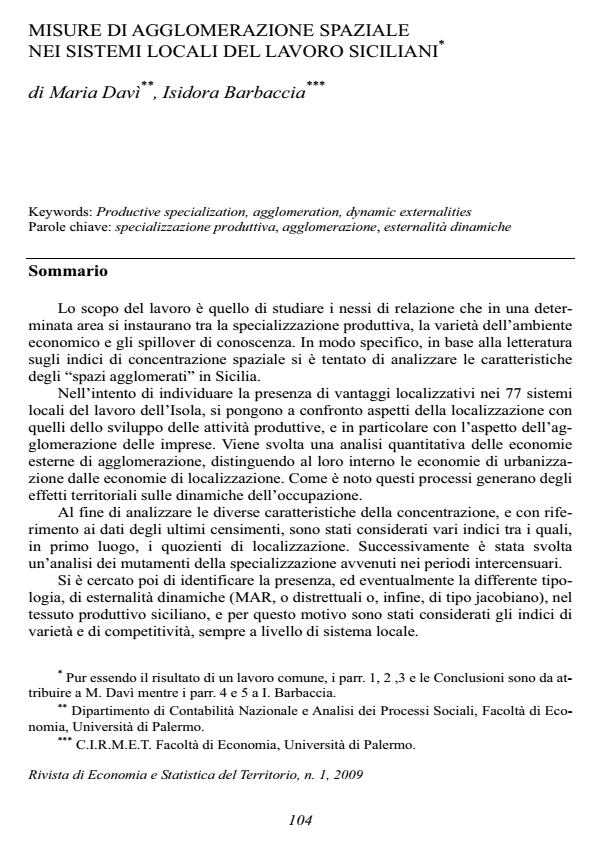Misure di agglomerazione spaziale nei Sistemi Locali del Lavoro siciliani
Titolo Rivista RIVISTA DI ECONOMIA E STATISTICA DEL TERRITORIO
Autori/Curatori Maria Davì, Isidora Barbaccia
Anno di pubblicazione 2009 Fascicolo 2009/1
Lingua Italiano Numero pagine 33 P. 104-136 Dimensione file 312 KB
DOI 10.3280/REST2009-001005
Il DOI è il codice a barre della proprietà intellettuale: per saperne di più
clicca qui
Qui sotto puoi vedere in anteprima la prima pagina di questo articolo.
Se questo articolo ti interessa, lo puoi acquistare (e scaricare in formato pdf) seguendo le facili indicazioni per acquistare il download credit. Acquista Download Credits per scaricare questo Articolo in formato PDF

FrancoAngeli è membro della Publishers International Linking Association, Inc (PILA)associazione indipendente e non profit per facilitare (attraverso i servizi tecnologici implementati da CrossRef.org) l’accesso degli studiosi ai contenuti digitali nelle pubblicazioni professionali e scientifiche
Spatial agglomeration indicators in the Sicilian Local Labour Systems Objectives - This paper examines the links among productive specialization, variety of the economic environment and knowledge spillovers on the basis of the territorial analyses present in the current literature. With the aim of identifying localization benefits in a particular area, some aspects of business settling are compared with trends in the development of economic activities and, particularly, with agglomeration process of the firms. Methods and Results The empirical analysis will be carried out pointing to the dynamics of employment consequent to the effects of the externalities above mentioned. Employment data are taken from the Manufacturing and Service Censuses of the years 1981, 1991 and 2001 and refer to the 77 Sicilian Local Labour Systems. Precisely, data pertain to the following sections of the classification ATECO 2002: Mining and quarrying (C), Manufacturing (D) and Total private services (G, H, I, J, K). We consider some suitable economic indicators to depict the characteristics of concentration: _ localization ratios for studying the evolutionary trends in specialization for different types of economic activity; _ diversity measures, based on a Hirschman-Herfindahl index, suggesting the presence of Jacobs-type dynamic externalities or, on the contrary, the operativeness of MAR dynamic effects; _ competition indices to gather information about the competition levels of the markets depending on their structure; _ agglomeration indices, to measure the geographic concentration of the economic activity connected to high and/or increasing industrial concentration levels in the adjacent LLS. Conclusions The agglomeration process results from inter-sector links, easing the diffusion of innovations thanks to the variety of urban contexts. Agglomeration forces appear to be outweighed, especially since 2001, by the influence of co-agglomeration factors due to the presence, in the same local reality, of small-sized enterprises belonging to different sectors. Owing to the increasing interdependence among sectors, these effects caused a redistribution of employment among the different groups of economic activities. The indexes showed how, during the inter-census gaps, a despecialization trend took over, bringing local production structures constantly closer to the average regional values.
Maria Davì, Isidora Barbaccia, Misure di agglomerazione spaziale nei Sistemi Locali del Lavoro siciliani in "RIVISTA DI ECONOMIA E STATISTICA DEL TERRITORIO" 1/2009, pp 104-136, DOI: 10.3280/REST2009-001005